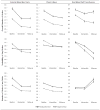Using Incentives to Improve Resource Utilization: A Quasi-Experimental Evaluation of an ICU Quality Improvement Program
- PMID: 26496444
- PMCID: PMC4684419
- DOI: 10.1097/CCM.0000000000001395
Using Incentives to Improve Resource Utilization: A Quasi-Experimental Evaluation of an ICU Quality Improvement Program
Abstract
Objectives: Healthcare systems strive to provide quality care at lower cost. Arterial blood gas testing, chest radiographs, and RBC transfusions provide an important example of opportunities to reduce excess resource utilization within the ICU. We describe the effect of a multifaceted quality improvement program designed to decrease the avoidable arterial blood gases, chest radiographs, and RBC utilization on utilization of these resources and patient outcomes.
Design: Prospective pre-post cohort study.
Setting: Seven ICUs in an academic healthcare system.
Patients: All adult ICU patients admitted to study ICUs during consecutive baseline (n = 7,357), intervention (n = 7,553), and follow-up (n = 7,657) years between September 2010 and August 2013.
Interventions: A multifaceted quality improvement program including provider education, audit and feedback, and unit-based provider financial incentives targeting arterial blood gas, chest radiograph, and RBC utilization.
Measurements and main results: The primary outcome was the number of orders for arterial blood gases, chest radiographs, and RBCs per patient. Compared with the baseline period, unadjusted arterial blood gas, chest radiograph, and RBC utilization in the intervention period was reduced by 42%, 26%, and 17%, respectively (p < 0.01). After adjusting for potentially relevant patient factors, the intervention was associated with 128 fewer arterial blood gases, 73 fewer chest radiographs, and 16 fewer RBCs per 100 patients (p < 0.01). This effect was durable during the follow-up year. This reduction yielded an approximate net savings of $1.5 M in direct costs over the intervention and follow-up years after accounting for the direct costs of the program. Unadjusted hospital mortality decreased from 7% in the baseline period to 5.2% in the intervention period (p < 0.01). This reduction remained significant after adjusting for patient factors (odds ratio = 0.43; p < 0.01).
Conclusions: Implementation of a multifaceted quality improvement program including financial incentives was associated with significant improvements in resource utilization. Our findings provide evidence supporting the safety, effectiveness, and sustainability of incentive-based quality improvement interventions.
Conflict of interest statement
Similar articles
-
Impact of a Sequential Intervention on Albumin Utilization in Critical Care.Crit Care Med. 2016 Jul;44(7):1307-13. doi: 10.1097/CCM.0000000000001638. Crit Care Med. 2016. PMID: 26963324
-
Effect of a Quality Improvement Intervention With Daily Round Checklists, Goal Setting, and Clinician Prompting on Mortality of Critically Ill Patients: A Randomized Clinical Trial.JAMA. 2016 Apr 12;315(14):1480-90. doi: 10.1001/jama.2016.3463. JAMA. 2016. PMID: 27115264 Clinical Trial.
-
Results of a collaborative quality improvement program on outcomes and costs in a tertiary critical care unit.Crit Care Med. 1999 Sep;27(9):1768-74. doi: 10.1097/00003246-199909000-00011. Crit Care Med. 1999. PMID: 10507596
-
Implementation of a quality improvement initiative to reduce daily chest radiographs in the intensive care unit.BMJ Qual Saf. 2016 May;25(5):379-85. doi: 10.1136/bmjqs-2015-004151. Epub 2015 Sep 8. BMJ Qual Saf. 2016. PMID: 26350068 Review.
-
Pay for performance in the intensive care unit--opportunity or threat?Crit Care Med. 2009 Mar;37(3):852-8. doi: 10.1097/CCM.0b013e3181962b0b. Crit Care Med. 2009. PMID: 19237887 Review.
Cited by
-
Interventions to reduce low-value care in intensive care settings: a scoping review of impacts on health, resource use, costs, and the environment.Intensive Care Med. 2024 Dec;50(12):2019-2030. doi: 10.1007/s00134-024-07670-7. Epub 2024 Oct 25. Intensive Care Med. 2024. PMID: 39453490 Free PMC article.
-
Modes of mechanical ventilation vary between hospitals and intensive care units within a university healthcare system: a retrospective observational study.BMC Res Notes. 2018 Jul 3;11(1):425. doi: 10.1186/s13104-018-3534-z. BMC Res Notes. 2018. PMID: 29970159 Free PMC article.
-
Behaviour modification interventions to optimise red blood cell transfusion practices: a systematic review and meta-analysis.BMJ Open. 2018 May 18;8(5):e019912. doi: 10.1136/bmjopen-2017-019912. BMJ Open. 2018. PMID: 29776919 Free PMC article.
-
Audit and feedback to improve laboratory test and transfusion ordering in critical care: a systematic review.Implement Sci. 2020 Jun 19;15(1):46. doi: 10.1186/s13012-020-00981-5. Implement Sci. 2020. PMID: 32560666 Free PMC article.
-
Implementation of the Connect for Health pediatric weight management program: study protocol and baseline characteristics.J Comp Eff Res. 2021 Aug;10(11):881-892. doi: 10.2217/cer-2021-0076. Epub 2021 May 24. J Comp Eff Res. 2021. PMID: 34024120 Free PMC article.
References
-
- Halpern NA, Pastores SM. Critical care medicine in the United States 2000–2005: an analysis of bed numbers, occupancy rates, payer mix, and costs. Crit Care Med. 2010;38(1):65–71. - PubMed
-
- Pronovost PJ, Marsteller JA, Goeschel CA. Preventing bloodstream infections: a measurable national success story in quality improvement. Health affairs. 2011;30(4):628–634. - PubMed
-
- Hewson-Conroy KM, Burrell AR, Elliott D, et al. Compliance with processes of care in intensive care units in Australia and New Zealand--a point prevalence study. Anaesthesia and intensive care. 2011;39(5):926–935. - PubMed
-
- Rothschild JM, Landrigan CP, Cronin JW, et al. The Critical Care Safety Study: The incidence and nature of adverse events and serious medical errors in intensive care. Critical care medicine. 2005;33(8):1694–1700. - PubMed
-
- Agency Healthcare Research Quality. 2013 National Healthcare Quality Report. Rockville, MD: Agency for Healthcare Research and Quality; 2014. p. 14-0005.
MeSH terms
Grants and funding
LinkOut - more resources
Full Text Sources
Other Literature Sources


